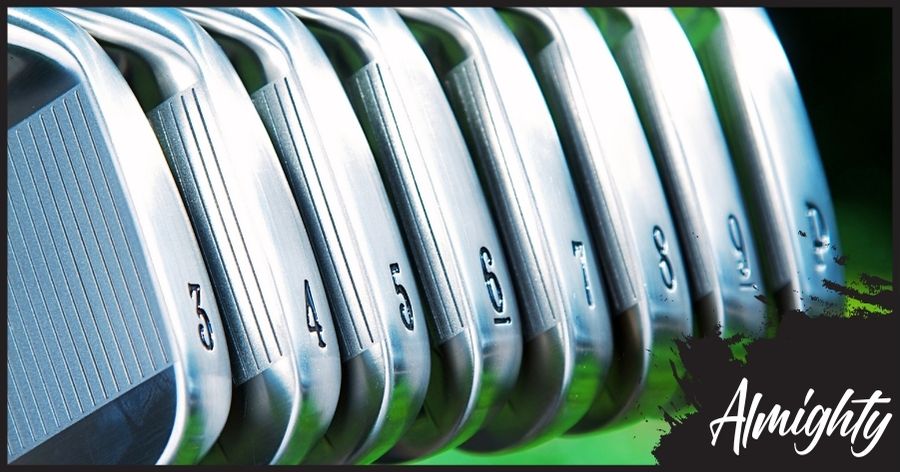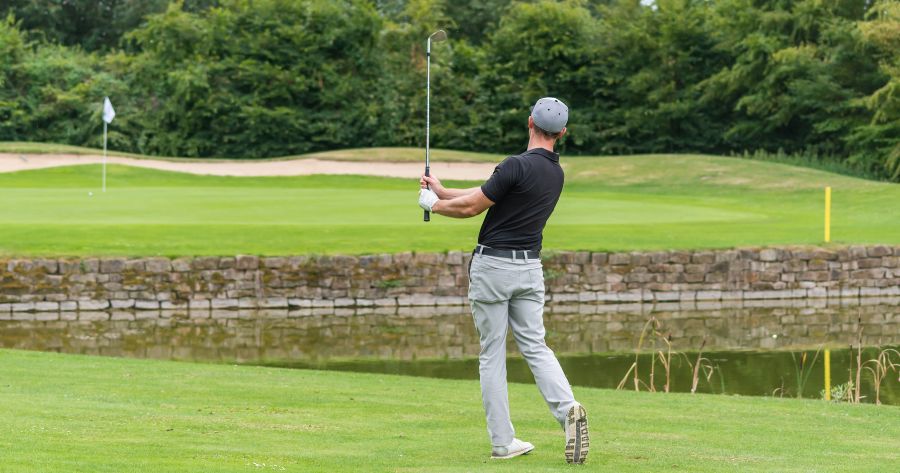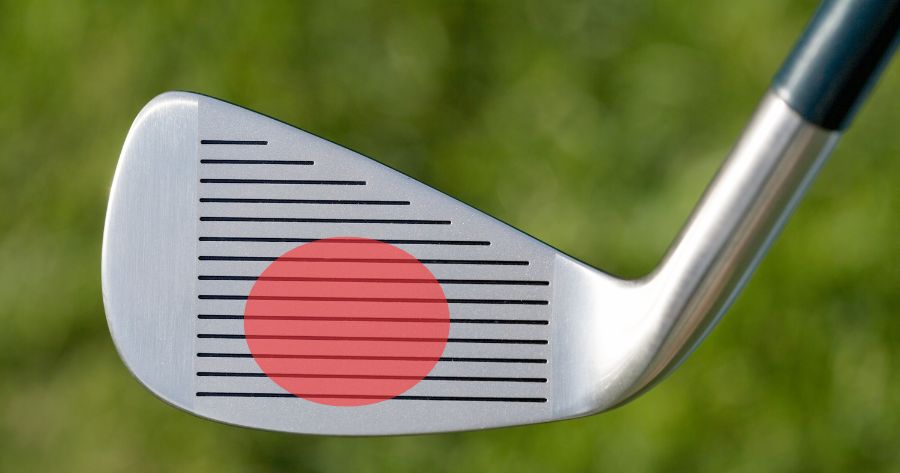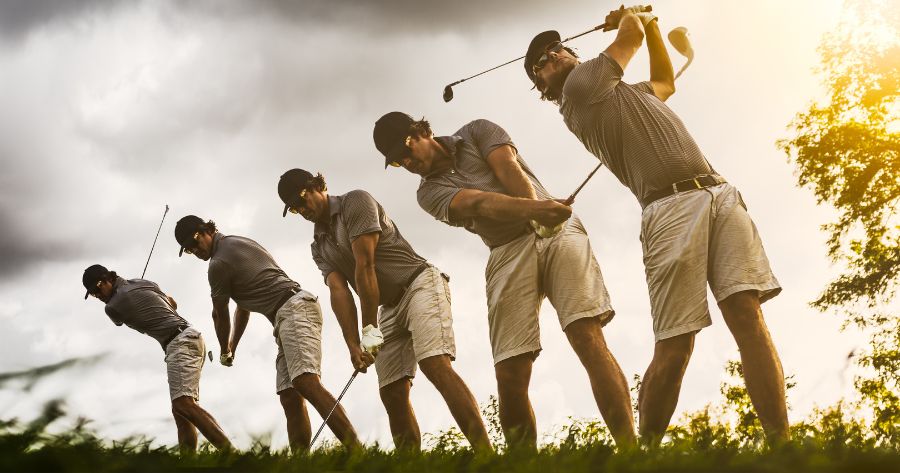
Key Takeaways – Blades vs Cavity back
- Cavity back irons feature greater forgiveness and a larger sweet spot, making them ideal for mid to high-handicap golfers as they’re easier to hit the ball.
- Blade irons provide superior control, feedback, and shot-shaping abilities, catering to low-handicap players and professionals.
- Swing speed, forgiveness needs, and desired ball flight are crucial factors in choosing between blades and cavity backs.
- The best choice depends on individual skill level, playing goals, and budget, with professional fitting recommended for optimal performance.
When I first picked up a set of blades, there were three things I wanted:
First, I tried to look cool to my friends. I wanted them to say “damn, he’s playing with blades?” or “damn, what clubs are those?”.
Secondly, I wanted to intimidate other golfers and show them I was good, without actually telling them.
Lastly, I thought I was confident enough in my golf game to start using what the pros were using and hoped it would lower my score.
Well, none of that materialized!
I struggled!
Instead of improving my game, they only highlighted my weaknesses.
That’s when I switched back to my cavity back irons and started producing scores I was used to.
In this text, we’ll jump into the differences between blades and cavity backs, exploring how each can impact your game.
Whether you’re a beginner trying to improve your average golf scores or a seasoned player looking for a change, understanding these two types of irons could make all the difference in your performance on the course.
What are blades in golf?

Blades, often called muscle-back irons, are a classic choice for many golfers. In fact, blade irons are generally favored among tour pros.
They feature a compact head shape and provide a purer connection with the ball.
That feeling? Priceless.
Out of 10 shots I’d hit, I’d probably flush 2 and it felt amazing.
You can really sense the control and precision during your swing.
Pros
- Control: Blades offer incredible control. You can shape your shots with ease—hook it, slice it, whatever you need.
- Feedback: Bladed irons deliver feedback on every swing. If you hit one from the sweet spot? That satisfying thwack will have you grinning for days.
- Aesthetics: Let’s be honest—blades look cool. Their sleek design appeals to purists who appreciate traditional golf gear.
- Lower Center of Gravity: This helps with trajectory control. You can keep your shots low during windy days or punch under trees.
Cons
- Forgiveness: Blades aren’t as forgiving as cavity backs. You need to hit the center of the club on every shot you take. If you miss the sweet spot, even just a few centimeters, expect a less-than-stellar outcome. It’s brutal, especially when you’re not playing your best.
- Distance: Struggling to get the same distance as cavity backs? That’s a common issue. Blades require precise strikes to see full yardage. Again if you don’t hit the sweet spot, the distance loss is noticeable.
- Complicated for Higher Handicaps: If your game isn’t quite there yet, blades may not be your best friend. They can magnify inconsistencies, leading to frustration on the course.
- Accuracy Needed: You’ll need to dial in your swing mechanics. Blade enthusiasts can fend off those nasty mishits, but casual players might find them challenging.
If you’re used to forgiving irons, switching over to blades will come with a steeper learning curve.
The enhanced feedback from blades can be a double-edged sword, as mishits are felt more acutely, potentially affecting your confidence.
Who should play Blade Irons?

Blade irons are best suited for low-handicap golfers and professionals with consistent ball-striking abilities.
These players benefit from the enhanced control and shot-shaping capabilities that blades offer.
If you’ve honed your technique and boast a low handicap, these clubs might be your ticket to revealing your full potential.
- Low Handicappers: If your handicap sits below 10, forged blades can elevate your game. They reward precision like nothing else.
- Players Focusing on Shot-Shaping: Want to work the golf ball around trees or execute those delicate fades? Blades support your creativity on the green.
- Golfers Seeking an Intimate Connection: If you cherish the feedback of every swing, blades are for you. They’ll help you refine your skills and improve your overall game.
Competitive players who prioritize precision and workability over forgiveness often gravitate toward blades.
Purists who appreciate the traditional blade iron look and feel may also prefer them, regardless of skill level.
What are cavity back irons?
Cavity back irons are designed with a specific purpose: to enhance forgiveness and improve your game.
The back of the clubhead features a hollowed-out “cavity” and creates a more expansive clubface, which helps distribute weight around the perimeter.
If you’re looking for something easier to hit, or want to be more consistent with your ball striking, these golf clubs are typically preferred.
Pros
- Forgiveness: Cavity back irons shine when it comes to forgiveness due to the “cavity” in the back of the club head. They reduce the impact of mis-hits, allowing you to maintain distance even when you don’t strike the ball perfectly.
- Weight Distribution: That extra weight around the edges? It helps minimize twisting on off-center shots, boosting your confidence.
- Distance Control: You’ll notice a lower center of gravity as well, giving you higher launch angles and allowing you to hit the golf ball higher.
- Plus, they’re generally easier to control, making them a go-to choice for many players looking to improve their overall consistency.
Cons
While cavity irons offer plenty of benefits, they’re not without a few drawbacks.
- The increased forgiveness can mask swing flaws, potentially hindering long-term skill development.
- You might find it challenging to shape shots or control trajectory as precisely as with blade irons because it’s built more for consistency than artistry.
- One key argument low handicap golfers keep bringing up is that cavity back irons lack the pure feedback a blade provides. Even if you flush the ball, it doesn’t provide the tactile response blades offer.
- Lastly, the larger club head and thicker topline may appear less aesthetically pleasing to players who prefer a more traditional look.
Game Improvement Cavity Back
Cavity back or game improvement irons are designed for maximum forgiveness and distance, essentially taking forgiveness to the next level.
These cavity back irons have a larger cavity, wider sole, and more offset than standard cavity backs. Additionally, you’ll notice a thicker topline and a larger overall club head at address.
The lightweight materials paired with enhanced technology – like face inserts and vibration-dampening systems – make them feel buttery smooth at impact.
They’re usually the best set of irons for high-handicap golfers or those new to the game, as they minimize the negative impact of inconsistent ball-striking.
Think of them as training wheels for the golf course, helping you learn while still giving you the chance to perform. You might snag a few extra pars as you learn the ropes.
Players Cavity Back
Players’ cavity backs cater to golfers seeking a balance of control and forgiveness, allowing for shot-shaping capabilities while still providing some margin for error.
These irons aren’t as forgiving as game improvement irons though, as they feature a smaller cavity and less offset than game improvement models.
With a sleeker profile than game improvement models, they still deliver on nice, predictable trajectories.
They’re designed for mid-to-low handicap players wanting that extra edge without sacrificing feel completely.
You could say they’re the middle ground, giving you versatility without overwhelming your game and providing a stop-gap as you progress to blades in the future.
Who Should Play Cavity Back Irons?

Cavity back irons suit a wide range of golfers, particularly high to mid-handicappers or those striving to improve.
If you consistently struggle with ball contact, these clubs can make a significant difference. They’re forgiving enough to maintain your confidence but offer the look and feel you desire as you progress.
If you’re someone who enjoys hitting that fantastic draw but also needs a bit of help on tougher days, these might just become your new best friends.
Eventually, your choice depends on your skill level, swing characteristics, and personal preferences. Consider getting fitted by a professional to find the best cavity back irons for your game.
The biggest differences between blade vs cavity back irons
Blade and cavity back irons differ significantly in design and performance characteristics but the biggest difference would be geared towards forgiveness.
Forgiveness Factor 1: Bigger Sweet Spot

Cavity backs shine with their bigger sweet spot.
Ever notice how some clubs just seem to hit right every time? That’s the sweet spot at play, spread out across the face of cavity backs.
With more area for the ball to make contact, mishits end up feeling less punishing.
You don’t need to be perfectly aligned to still get a decent distance either.
Blades, on the other hand, have a smaller sweet spot.
If you catch the ball a bit off-center, you’ll feel it instantly because the impact will ring up the shaft and into your arms.
Forgiveness Factor 2: Offset
Offset refers to the distance between the leading edge of the hosel and the leading edge of the clubface.
Cavity backs typically feature more offset than blades. This design feature positions the clubface slightly behind the shaft, promoting a more consistent setup and swing path.
The increased offset in cavity backs also assists in getting the ball airborne more easily.
It effectively moves the center of gravity back, promoting a higher launch angle. This characteristic benefits players who struggle with achieving optimal ball height.
Blades, conversely, have minimal offset.
While this provides a cleaner look at address, it requires more skill to consistently strike the ball with a square clubface.
The reduced offset in blades allows for greater shot-shaping capabilities, appealing to low-handicap players who prioritize workability.
Which is Better? Cavity Back Irons vs Blades
Choosing between blades and cavity back irons is a crucial decision for golfers. Each type offers distinct advantages and challenges, catering to different skill levels and playing styles.
Which Provides More Forgiveness?
Cavity backs crush blades when it comes to forgiveness.
Cavity backs’ larger sweet spots absorb those imperfections, offering a more forgiving experience on the course. This feature is particularly beneficial for mid to high-handicap golfers who struggle with consistent ball-striking.
With weight distributed around the perimeter, they minimize the impact of off-center hits. This increased forgiveness helps maintain ball speed and direction, even when you don’t strike the ball perfectly or if your swing isn’t perfect.
Blades, on the other hand, have a smaller sweet spot due to their compact design. They’re less forgiving on off-center hits, resulting in more significant losses in distance and accuracy.
So, if you’re looking for a club that helps you bounce back from those less-than-stellar swings, cavity backs are the way to go.
Which Provides More Ball Control?
Blades reign supreme in ball control and shot-shaping abilities, and give you that pure feedback you crave.
Their compact design and weight distribution allow skilled players to manipulate the ball flight with precision. You can easily hit draws and fades, and control trajectory with blades.
The thin topline and minimal offset of blades provide better visual feedback at address, helping you align the clubface more accurately. This design also allows for more consistent ball-striking, as you can see exactly where the clubface contacts the ball.
Don’t get me wrong, cavity backs, while offering less precise control, still provide a decent amount of shot-shaping capabilities for most golfers (probably more than enough for recreational golfers).
However, advanced players might find it more challenging to work the ball with cavity backs compared to blades.
Which Provides More Distance?
When it comes to distance, cavity backs typically take the crown.
Their design allows for a lower center of gravity, which helps launch the ball higher and with more forgiveness. This combination often results in longer shots, especially for mid to high-handicap players.
The perimeter weighting in cavity backs also helps maintain ball speed on off-center hits, contributing to consistent distances across the clubface.
Game improvement cavity backs, in particular, are engineered to maximize distance through various technologies.
Blades, while capable of producing significant distance in the hands of skilled players, typically offer less overall distance for the average golfer.
The compact design and smaller sweet spot mean that off-center hits can result in substantial distance loss. But, when struck perfectly, blades can produce comparable or even superior distance due to their ability to compress the ball efficiently.
Who Are Cavity Backs Designed For?
Cavity backs cater to a wide range of players, especially those starting their golfing journey.
If you’re a mid-to-high handicapper or just getting your feet wet, cavity backs offer that much-needed forgiveness.
If you’re new to golf or struggle with consistent ball-striking, cavity backs can help boost your confidence and improve your scores.
The larger sweet spot and more forgiving design make it easier to get the ball airborne and hit straighter shots.
Even some better players opt for cavity backs, particularly players’ cavity backs, which blend forgiveness with workability.
They essentially offer a middle ground between full game improvement cavity backs and blades, catering to golfers who want a balance of forgiveness and control.
Who Are Bladed Irons Designed For?
Blades are the go-to choice for low handicappers, those seasoned players who crave precision.
These players can fully leverage the control and workability that blades offer, shaping shots with precision and finesse.
If you consistently strike the ball in the center of the clubface and want maximum feedback and control over your shots, blades might be the right choice.
Some mid-handicap golfers with solid ball-striking skills also choose blades, often for the challenge and feedback they provide.
Honestly, it’s crucial to assess your abilities before making this choice, as playing with blades can be demanding and potentially frustrating for less skilled players.
Which Tends To Be More Expensive?
Generally, blades tend to be more expensive than cavity back irons.
The precision engineering and materials used in blade construction often result in higher production costs, which are reflected in the retail price.
Blades are typically forged from a single piece of high-quality steel, requiring more intricate manufacturing processes.
This forging process contributes to the superior feel and feedback that blades are known for, but it also increases the cost.
Cavity backs, especially game improvement models, are often cast rather than forged. This manufacturing process is less expensive, allowing for more affordable pricing.
But, high-end cavity backs, particularly those designed for better players, can also command premium prices due to advanced technologies and materials used in their construction.
It’s important to note that price shouldn’t be the sole determining factor in your choice.
Consider your skill level, playing goals, and budget when deciding between blades and cavity backs.
Remember, the most expensive clubs aren’t always the best fit for your game.
Should You Play Cavity Backs, Blades or Muscle Backs?
Choosing between blades, muscle backs (MB), or cavity backs isn’t just about looks; it’s about what fits your game and style best.
Assess your swing speed, forgiveness needs, and shot-shaping preferences to make the best choice.
Swing Speed

Swing speed plays a crucial role in determining the best iron type for your game.
If you’ve got a faster swing speed, blades or MB might be your go-to choice. These designs allow you to compress the ball more effectively, resulting in better control and feel.
For golfers with moderate swing speeds, cavity backs offer a sweet spot. They provide a balance between forgiveness and control, helping you achieve consistent results.
If your swing speed falls on the slower side, game improvement cavity backs can be a game-changer. They’re engineered to maximize distance and forgiveness, compensating for lower swing speeds.
Remember, swing speed isn’t just about raw power. It’s about consistency and control too. Who cares if you can crank it 100+ mph if it’s going out of bounds?
Forgiveness
Forgiveness is a key factor when choosing between these irons and cavity backs reign supreme in this department.
Their perimeter weighting and larger sweet spot make them more forgiving on off-center hits.
If you’re a mid-to-high handicapper, cavity backs can be your best friend on the course. They help minimize the effect of mishits, keeping your shots straighter and closer to your target.
Game improvement cavity backs take this concept even further by offering maximum forgiveness for beginners and high handicappers.
Blades and MB, on the other hand, offer precise feedback as a tradeoff for forgiveness.
For low handicappers and pros, this feedback is invaluable for fine-tuning their game.
But, if you’re still working on consistency, the unforgiving nature of blades might do more harm than good to your confidence and scores.
Ball Flight
Blades and MB typically produce a lower, more penetrating ball flight, which can be a benefit when it’s windy.
Cavity backs, on the other hand, are designed to launch the ball higher. This higher trajectory can help you achieve softer landings on the green, potentially improving your approach shots.
For golfers who struggle with getting the ball airborne, cavity backs can be a game-changer.
Again, players cavity backs offer a middle ground.
They provide a slightly higher ball flight than blades but still allow for some shot-shaping capabilities.
This makes them an excellent choice for improving players looking to transition from game improvement irons to more advanced designs.
Distance
When it comes to distance, cavity backs often have an edge. Their design allows for a lower center of gravity, helping you launch the ball higher and farther.
Game improvement cavity backs, in particular, are engineered to maximize distance, making them ideal for golfers looking to add yards to their iron shots.
Blades and MB, while not distance-focused, offer precision and control. Low-handicap players often prefer the consistent distances these clubs provide, allowing for more predictable shot-making.
With blades, you might sacrifice some distance, but you gain the ability to dial in your yardages with incredible accuracy.
Shot Shaping
If shot shaping is a crucial part of your game, blades and MB shine.
Their compact head design and minimal offset means you can easily hit draws, fades, and even intentional hooks or slices when needed.
Cavity backs, while offering less workability, still allow for some shot shaping.
Players cavity backs, in particular, strike a balance between forgiveness and workability.
They’re a great option if you’re looking to develop your shot-shaping skills without sacrificing too much forgiveness.
For most amateur golfers, the ability to shape shots isn’t as critical as consistency. Cavity backs can help you achieve straighter, more predictable shots.
FAQ – Blades vs Cavity Back
Let’s jump into some frequently asked questions about blades and cavity backs. These questions will help clarify common misconceptions and provide additional insights into the world of golf irons.
What About “Muscle Back” Irons?
Muscle back (MB) irons are essentially modern-day blades. Both terms essentially mean the same thing.
They feature a solid back design with a small amount of perimeter weighting, offering a blend of traditional blade characteristics and slightly improved forgiveness.
MB provides exceptional feel and control, much like their blade counterparts.
They’re crafted for skilled players who desire precise shot-making abilities.
The added mass behind the sweet spot enhances feedback and workability.
What is a “Split Set”?
A split set combines a different set of iron types within a single set of golf clubs.
It’s a strategic approach golfers use to maximize performance across various club lengths and situations on the course.
Typically, a split set includes a cavity back set for longer irons (3-6) and blades or MB for short irons (7-PW). This configuration leverages the forgiveness of cavity backs for longer shots and the precision of blades for shorter approaches or even wedge shots.
Split sets offer versatility and customization as they allow golfers to benefit from the strengths of both iron types.
Do Pro Golfers Ever Use Cavity Back Irons?
Yes, pro golfers do use cavity back irons, though it’s less common than blades or MB. The choice often depends on individual preferences and playing styles.
Some pros opt for cavity backs in their long irons for added forgiveness and distance. Others might use a full set of cavity backs if it suits their game.
Tour pros like Dustin Johnson and Rory McIlroy use blades but have also been known to use cavity backs at times.
Eventually, pros choose clubs that optimize their performance. While many prefer the workability of blades, the increased forgiveness of cavity backs can be beneficial, especially in challenging conditions or for specific shot types.
Final Thoughts: Should You Buy Blades or Cavity Backs?
Choosing between cavity backs and blades isn’t a one-size-fits-all decision. It’s about finding the right fit for your golf bag and your game.
If you’re a mid-to-high handicapper, a set of cavity back irons (or game improvement clubs) is your best bet. They offer forgiveness for mishits and boost your confidence on the course.
For low handicappers and pros, blade golf clubs are typically the go-to set. They provide superior control and feedback, letting you shape shots with precision. But remember, even some pros opt for cavity backs when they need a little extra help.
Consider your swing speed too. If you swing with power, the feedback from blades can help you fine-tune your game. They reward precision and can even make you feel like a pro.
On the flip side, if your swing’s a bit slower or you’re still building your skills, you may benefit from cavity backs as they provide that extra forgiveness and help you launch the ball higher.
Think about your goals on the course. Are you looking to lower your scores quickly? Cavity backs, in the long run, can help. Want to shape your shots? Blades usually are the way to go.
Don’t forget about your budget too. Blades typically cost more due to their precision engineering, whereas cavity backs, especially game improvement models, are often more wallet-friendly.
Eventually, the game of golf is about enjoyment. Whether you lean toward blades for that finesse or cavity backs for confidence, pick which irons best fit your game because the best club is one that helps you feel good when you step up to the tee.
Before You Go
Blades are truly for seasoned, low-handicap, scratch, and even pro golfers.
Truthfully, if you’re still looking at the difference between blades vs cavity back irons, then you might not be ready for blades.
But that doesn’t mean you can’t work your way towards that goal.
If you’re an avid golfer but haven’t made the jump to mid-low handicap, then I created a post on how to break 90 in golf:
If you’re a beginner looking to improve your game drastically, then I created another post on how to break 100:
Cheers!
